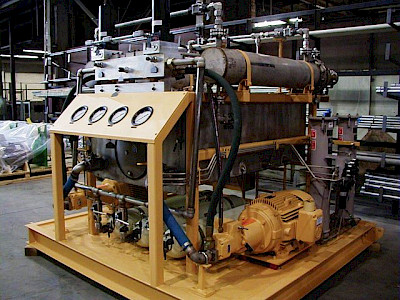Maintenance of FRF in Turbine EHC system
The purpose of the article is to sensitize the reader bout FRF Maintenance and adopt best practices from the industry.

What is a Turbine EHC system?
Electro-Hydraulic Control System (EHC System or the DEH System) of a Turbine is the most critical equipment of a Power Plant. It’s the heart of a turbine which controls Steam flow into the turbine. A malfunctioning EHC System can lead to Turbine stoppage and thereafter create a dominoes effect on the synchronized processes of the power plant. Breakdown-free and reliable operation of the EHC System is the biggest challenge of the O&M Manager and Engineers.
Due to High Steam Pressure & Temperature in the vicinity of a Steam Turbine, as safety compliance, it is a mandate to use Fire Resistant Fluids (FRF) for Hydraulic control of the EHC System. A specially designed synthetic fluid called Tri-Xylenyl Phosphate Ester (TXP) demonstrates best Fire Resistant properties for the application.
Phosphate Esters are polar fluids with excellent lubricating properties that can operate under extreme conditions. However, it requires strict control in order to extend their useful lifespan. This article covers best practices for strict maintenance required to prevent the untimely destruction of phosphate ester fluids.
 Water and acids de-grade FRF
Water and acids de-grade FRF
Phosphate Esters are manufactured under controlled environment through esterification of Phosphoric Acid, where water is a by-product.
Phosphoric Acid + Alcohol → Phosphate Ester + Water
Unfortunately, Phosphate Esters are highly hygroscopic (tendency to absorb water) and the esterification process is reversible when Phosphate Esters come in contact with water. This is called ester hydrolysis. The higher the water content and temperature, the faster ester will break down by hydrolysis.
Phosphate Ester + Water → Phosphoric Acid or Acid Phosphates + Alcohol
Thereby it is recommended to control water level, temperature and acidity in FRF of the EHC Systems. If not controlled efficiently, the acidity accelerates rapidly.
Total Acid Number (TAN) is a parameter to denote acid content accumulation in FRF. A high TAN Value degrades the fluid rapidly, decreases its viscosity and resistivity. Thereby causing acid corrosion of sensitive servo-valves and other system components of a EH System.

FRF de-gradation due to particles
Water and acid are not the only contaminants which can degrade the FRF. Since the dynamic oil film and fine learances in servo-valves are less than 5 microns, even the finest silt particles and sludge/varnish deposits from fluid degradation can hinder proper operation. Fine particles get trapped in clearances between the valve plunger and housing. This abrasive wear is known as seizing or grinding which results in wear rates that are a thousand times greater than anticipated by the valve manufacturer.
Therefore, it only makes sense to use very fine filtration (3-5 micron) for maintaining the EHC fluid.
Consequences of FRF de-gradation
- Acid, gel and sludge/varnish formation
- Valve sticking or blocking
- Reduced lubricity and film strength
- Corrosion, erosion and abrasion wear
- Reduced fluid resistivity
- Soot generation (entrained air)
- Short fluid life
The result is poor EHC system reliability and reduced turbine availability.
| Parameter | Unit | Value |
|---|---|---|
| Appearance | ASTM Color | Clear, < 3 |
| Water Content | ppm | < 500 |
| Kinematic Viscosity (at 40 degree Celsius) | cSt | 10.00% |
| Acidity (TAN) | mgKOH/gm | <0.15 |
| Particulate Contamination | ISO 4406 | <15/12 |
| Cleanliness Code | NAS 1638 | <5 |
Condition-based monitoring of FRF
It is highly recommended to carry out regular Fluid Analysis of FRF and identify any abnormalities in the trend for further preventive actions. Recommended Parameter Values for FRF:
EH OIL / FRF conditioning system
In order to have complete purification of FRF, an external FRF Reconditioning System is recommended comprising the latest technologies to meet the following functions:
- Solid contamination Super-fine Filtration
- Moisture in oil separation by Vacuum Dehydration technology
- TAN reduction by Ion Exchange technique
- EHC System Tank Moisture Removal by Inert Gas Blanketing technique
Removal of Solid Particles from FRF
Removal of Solid particle contamination in FRF fluid should be carried out by usage of stage-wise Superfine Mechanical Filters (upto 1 micron, Beta 1000 rating) ensuring results better than NAS 4/5.
Moisture Separation from FRF
As FRF is hygroscopic in nature, water is mostly present in dissolved form. OEMs of EHC Systems often provide water absorbing filters. However, these fail to absorb the dissolved moisture content. Vacuum Dehydration technology is safe and recommended by FRF manufacturers for efficient separation of moisture / water in FRF.
TAN Reduction in FRF
OEMs of EHC Systems commonly provide Fuller’s Earth and Activated Alumina (Selexorb®) cartridges for maintenance of Low TAN value in FRF. However, TAN values in FRF is frequently reported beyond 0.2 values in most of the cases.
Technology of FRF regeneration and re-conditioning using special Weak Base Anion (WBA) resins under Ion Exchange method should be opted which has been successful for over 25 years in Europe and America.
Tan reduction success stories in India's power plant
Multiple Power Plants in India are facing the trouble of maintaining desired operational parameters of FRF. Below are results of successful cases of Indian Power plants where FRF Re-conditioning System has helped them in FRF Re-generation.
| Date | Moisture | TAN |
|---|---|---|
| 12.07.2017 | 860 | 1.83 |
| 17.07.2017 | 259 | 1.51 |
| 27.09.2017 | 784.3 | 0.53 |
| 13.10.2017 | <500 | 0.2 |
| Date | Moisture | TAN |
|---|---|---|
| 28.02.2015 | 331 | 0.96 |
| 30.11.2015 | 302 | 0.2 |
| Date | Moisture | TAN | NAS |
|---|---|---|---|
| Unit 1 | |||
| 26.04.2018 | 333 | 0.57 | 5 |
| 21.05.2018 | 205 | 0.14 | 4 |
| Unit 2 | |||
| 29.03.2018 | 329 | 0.4 | 5 |
| 24.04.2018 | 371 | 0.13 | 4 |
| Date | Moisture | TAN |
|---|---|---|
| 01.10.2016 | high | 0.81 |
| 10.11.2016 | 572 | 0.56 |
| 10.03.2017 | <500 | 0.14 |
| Date | Moisture | TAN |
|---|---|---|
| 05.12.2016 | N.A. | 0.4 |
| 29.12.2016 | <500 | 0.04 |
The purpose of the article is to sensitize the reader about FRF Maintenance and to adopt best practices from the industry. The data presented in the article has been researched over technical papers, presentations and the field performance results as observed at various power stations. None of the names have been revealed due to NDA compliances.
